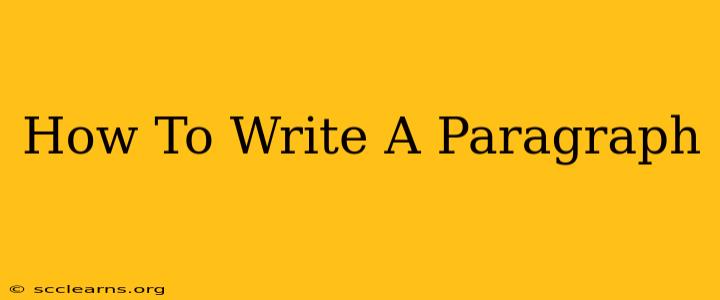Writing a paragraph might seem simple, but crafting effective paragraphs that are both clear and engaging is a crucial skill for any writer. A well-structured paragraph forms the backbone of strong writing, whether you're composing an email, a novel, or an academic paper. This guide will walk you through the essentials of paragraph writing, helping you improve your clarity and captivate your readers.
Understanding the Purpose of a Paragraph
Before diving into the mechanics, it's important to understand the purpose of a paragraph. Essentially, a paragraph is a group of related sentences that develop a single idea. Think of it as a mini-essay, focused on a specific point within a larger piece of writing. Each paragraph builds upon the previous one, contributing to the overall flow and coherence of your work.
Key Elements of a Strong Paragraph
Several key elements contribute to a well-crafted paragraph:
-
Topic Sentence: This sentence usually appears at the beginning and clearly states the main idea of the paragraph. It acts as a roadmap for the reader, guiding them through the information that follows. A strong topic sentence is concise and specific.
-
Supporting Sentences: These sentences elaborate on the topic sentence, providing evidence, examples, explanations, or details to support the main idea. They should be logically connected and flow smoothly from one to the next. Use transitions to create a coherent narrative.
-
Unity and Coherence: All sentences in a paragraph should directly relate to the topic sentence. Avoid including irrelevant information or tangents. Maintain coherence by using transitions, pronouns, and repetition of key words to connect ideas smoothly.
-
Adequate Development: A paragraph needs sufficient detail to fully explore the main idea. Don't leave the reader wanting more information or feeling that the point is underdeveloped.
-
Concluding Sentence (Optional): While not always necessary, a concluding sentence can effectively summarize the main point or offer a transition to the next paragraph. This provides a sense of closure and enhances readability.
Practical Tips for Writing Effective Paragraphs
Here are some practical tips to help you write strong, engaging paragraphs:
-
Focus on one idea per paragraph: Avoid overcrowding a paragraph with multiple ideas. This can confuse the reader and make your writing difficult to follow.
-
Vary sentence structure: Use a mix of simple, compound, and complex sentences to maintain reader interest and avoid monotony.
-
Use precise language: Choose words carefully to ensure clarity and accuracy. Avoid vague or overly general terms.
-
Proofread carefully: Errors in grammar and mechanics can distract the reader and undermine the effectiveness of your writing.
Mastering Paragraph Writing: A Continuous Process
Mastering paragraph writing is an ongoing process that involves practice and refinement. By paying attention to the elements discussed above and consistently striving for clarity and coherence, you can significantly improve your writing skills and create engaging content that captivates your readers. Don't be afraid to experiment, revise, and seek feedback to hone your craft. The more you write, the better you'll become at constructing effective paragraphs.

